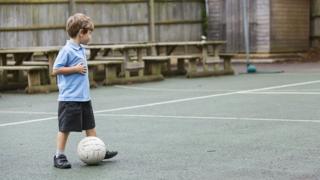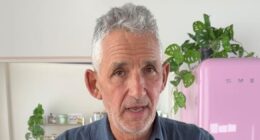 Image copyright Getty Images
Image copyright Getty Images The current plan is to have most children back in school across the UK by September.
But, with winter and fears of a resurgence of the virus approaching, what role could this play in spreading coronavirus?
How dangerous is coronavirus for children?
Children are at extremely low risk of becoming ill from the virus themselves.
Adults – and particularly older adults – are far more likely to be seriously ill and die from complications.
A study of more than 55,000 hospitalised coronavirus patients found that only 0.8% were under the age of 19.
More than three-quarters of all the people with confirmed coronavirus who were admitted to critical care units in England, Wales and Northern Ireland were 50 or older as of 31 July, according to a research charity. And fewer than 10% were younger than 40.
There have been some extremely rare cases of children developing an inflammatory syndrome similar to Kawasaki disease, and scientists are exploring a possible delayed immune response to coronavirus.
Can children pass on coronavirus to others?
A review of global studies by University College London (UCL) and the London School of Hygiene and Tropical Medicine found children were about half as likely to catch coronavirus as adults, meaning they would be less likely to pass it on.
The team reviewed more than 6,000 studies from around the world but found only 18 had good enough data.
Even the useable studies mostly took place during lockdowns when schools were not running at full capacity.
The Department for Education says an as-yet unpublished study of pupils and teachers at 100 schools in England will provide little evidence that the virus is transmitted in schools.
Public Health England, which ran the study due to be published later in the year, said coronavirus infections and outbreaks were “uncommon in educational settings during the first month after the easing of national lockdown”.
Both government and the researchers hailed this as a positive sign for schools returning in September.
READ RELATED: Pfizer applies for authorization to use its COVID-19 vaccine in under 5s
The study is based on data from a time when schools have been less than 10% full, though. They don’t give a picture of the risks of much fuller classrooms.
The government’s Scientific Advisory Group for Emergencies (Sage) said in countries where schools have reopened, data suggests it has made “little difference to community transmission”.
Teams of researchers around the world have tried to estimate how often children catch coronavirus and how often they are the first case which starts an outbreak.
Studies of clusters of infections in family groups across China, and cases in the French Alps, have concluded – based on contact tracing – that none of the infections were likely to have been introduced by children.
Community studies in Iceland, South Korea, Netherlands and Italy all found evidence children were less likely to have – or have had – the virus than adults. The Italian region tested 70% of its population.
A review of the evidence by a global team of researchers concluded: “The role of children in transmission is unclear, but consistent evidence is demonstrating a lower likelihood of acquiring infection, and lower rates of children bringing infections into households.”
What about the risks to staff?
More children in schools means more teachers working, and more parents at the school gates, and it’s not yet clear how those extra contacts might affect the spread of infection.
A study by UCL and the London School of Hygiene and Tropical Medicine suggested without adequate contact-tracing, reopening schools would contribute to a second wave of infection larger than the first.
They assumed children were half as infectious as adults, but they also used computer models to see how more parents returning to work or resuming other activities would affect the spread of the virus.
What if you don’t send schoolchildren back?
Opening schools involves some risk of spreading infection, but not opening schools also involves risk – just of a different kind.
Sage says school closures risked children’s educational outcomes, which in turn could impact their psychological wellbeing and long-term development. This is likely to hit the most vulnerable children the hardest.
When some schoolchildren returned earlier in the summer, younger year groups and those with exams coming up were generally prioritised.
This is because they have the most important educational needs and, for younger children, they may be less able to learn well at home.
What do I need to know about the coronavirus?
Source: BBC News – Health









